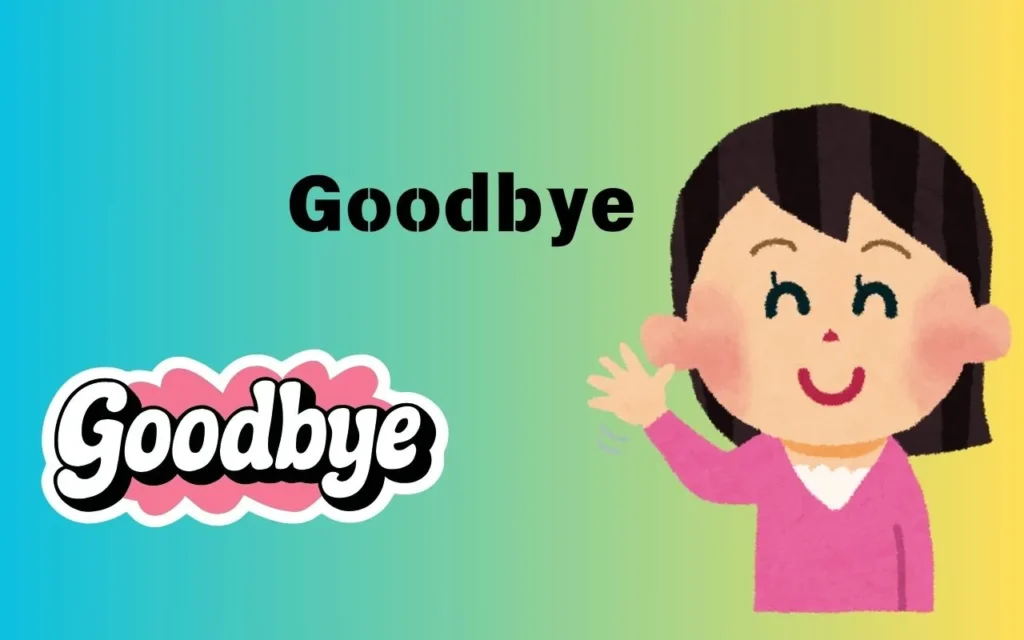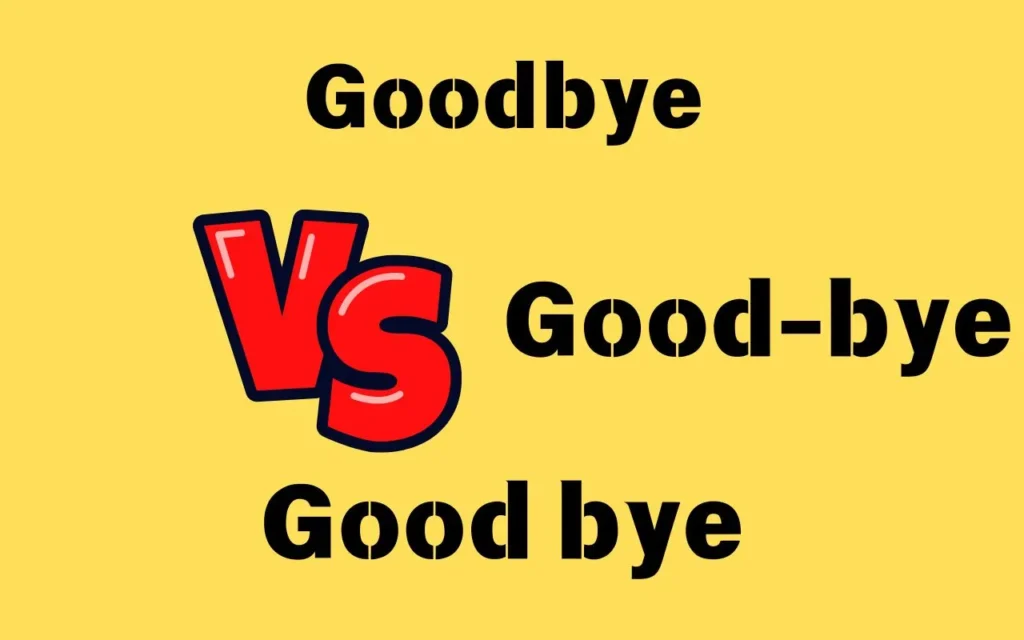Last updated on April 26th, 2025 at 11:50 am
Language evolves over time, and the way we spell and use words often reflects these changes.
The word “goodbye” is no exception, with its variations — goodbye, good bye, and good-bye — sparking debates about proper usage.
Goodbye, good-bye, or good bye—which one is correct? Explore the history, evolution, and proper use of this timeless farewell expression!
If you’ve ever wondered which form is correct and why, this comprehensive guide will help you navigate the nuances of this common farewell expression.
The Evolution of the Term ‘Goodbye’
The word goodbye has undergone significant changes over centuries. Its origins trace back to the expression “God be with ye,” a religious phrase used as a parting blessing in the 16th century.
Over time, the phrase was shortened to “good-b’w’y” and eventually became the modern term goodbye.
The shift reflects not only linguistic evolution but also cultural changes. As religious influences on language lessened, the word took on a more secular tone, becoming a simple way to say farewell without overt spiritual connotations.
Goodbye, Good bye, or Good-bye: Which Is Correct?
The Answer: Goodbye
The most widely accepted and modern form of the word is goodbye. Style guides, dictionaries, and common usage overwhelmingly favor this spelling as the standard form in contemporary English.
What About Good-bye?
Good-bye was historically the preferred spelling, especially in older literature and formal writing. However, hyphenated forms of words have largely fallen out of favor in modern English, leading to the dominance of the unhyphenated goodbye.
And Good bye?
Good bye as two separate words is considered incorrect in most contexts today. While it may occasionally appear in informal or creative writing, it is not recognized as standard English.
Key takeaway: If you want to use the most accepted version, stick with goodbye.
| Form | Status | Example Usage |
|---|---|---|
| Goodbye | Standard | “Goodbye, see you tomorrow!” |
| Good-bye | Outdated but acceptable | “She waved and said, ‘Good-bye.’” |
| Good bye | Incorrect or informal | “Good bye, my friend!” (rarely used) |
The Role of Dictionaries and Style Guides
Dictionaries like Merriam-Webster, Oxford English Dictionary, and Cambridge English Dictionary all list goodbye as the primary spelling. Similarly, major style guides such as The Chicago Manual of Style and AP Stylebook advocate for goodbye as the standard.
However, good-bye may still be seen in older publications or used by writers aiming for a vintage tone. This is a reminder that language evolves, and what was once common may eventually become archaic.
Tip: Always refer to your preferred style guide or dictionary when in doubt about spelling in professional or academic writing.
Regional Variations in Using Goodbye
While the spelling of goodbye is largely uniform across English-speaking regions, slight cultural and contextual variations exist in how the term is used:
- United States: Goodbye is commonly used in both formal and informal settings. Shortened alternatives like bye and see ya are frequent in casual speech.
- United Kingdom: Similar to the U.S., goodbye is the standard spelling, but phrases like cheerio or ta-ra are also popular informal farewells.
- Australia/New Zealand: While goodbye is widely understood, phrases like catch ya later and hooroo reflect local colloquialism.
- India: In addition to goodbye, phrases like ta-ta or bye-bye are widely used, often influenced by regional languages and cultural nuances.
These differences demonstrate how regional preferences can shape the way we say farewell.
Common Misconceptions About Saying Farewell
Misconception 1: Goodbye Is Too Formal
Many believe that goodbye is too formal and outdated for everyday use. However, it remains a versatile term that can suit both formal and informal contexts.
Misconception 2: All Variations Are Interchangeable
While some people use good-bye or good bye interchangeably with goodbye, these spellings can confuse readers or appear inconsistent. Sticking to the modern standard avoids ambiguity.
Misconception 3: Abbreviations Like “Bye” Are Improper
Shortened forms like bye or bye-bye are perfectly acceptable in informal speech and writing. These variations are widely recognized and carry the same meaning.
Examples of Saying Goodbye in Different Contexts

Formal Situations
- “Goodbye, it was a pleasure meeting you.”
- “Thank you for your time. Goodbye!”
Informal Situations
- “Bye! See you later!”
- “Catch you soon. Bye!”
Professional Settings
- “Goodbye, and thank you for attending the meeting.”
- “I’ll follow up via email. Goodbye!”
Creative Writing
- “Goodbye,” she whispered, her voice tinged with sadness.
- He smiled, saying, “Goodbye for now, but not forever.”
Tip: Match the tone of your farewell to the context and audience.
The Contraction ‘Goodbye’ and Its Historical Roots
Did you know that goodbye is actually a contraction? It stems from the phrase “God be with ye,” which was a common farewell in the 16th century. Over time, the phrase was shortened to “God b’w’ye,” then “good-b’ye,” and finally, goodbye.
This historical evolution highlights how language simplifies and adapts to everyday use. While we no longer use the original religious phrase, its essence remains in the word we use today.
Tracing the Etymology: From ‘God Be With Ye’ to Today
- 16th Century: “God be with ye” was used as a blessing when parting.
- 17th Century: The phrase was shortened to “good-b’ye” or “good-b’ye,” reflecting changes in speech patterns.
- 18th Century: The hyphenated form good-bye became standard in writing.
- Modern Day: Goodbye emerged as the dominant form, with good-bye becoming less common.
Fun fact: The evolution of goodbye mirrors similar transformations in other farewell phrases like farewell and adieu.
Impact of ‘Goodbye’ on Language and Culture
The word goodbye holds emotional and cultural significance. It marks moments of parting, often symbolizing transitions, endings, and even new beginnings.
- In Literature: Goodbye is frequently used to evoke emotion, whether in heartfelt farewells or bittersweet goodbyes.
Example: “So long as we live, they too shall live, for they are now a part of us, as we remember them. Goodbye, dear friend.” - In Pop Culture: Songs like “Goodbye Yellow Brick Road” by Elton John and “Goodbye My Lover” by James Blunt reflect its emotional resonance.
The word has become a universal symbol of closure, making it a key part of human expression.
Creative Ways to Say Goodbye in Writing and Speech
Looking for a more unique way to say goodbye? Here are some creative alternatives:
- Formal:
- Farewell
- Until we meet again
- Take care
- Informal:
- See ya later
- Catch you soon
- Take it easy
- Playful/Creative:
- Adios, amigo
- Bye for now
- Toodle-oo
By tailoring your goodbye to the context, you can leave a lasting impression.
FAQs
What is the correct spelling: goodbye, good-bye, or good bye?
The correct spelling is “goodbye.” It is the modern and widely accepted form, while “good-bye” is outdated, and “good bye” is incorrect.
Why is goodbye spelled without a hyphen today?
Language evolves, and hyphenated forms like “good-bye” have fallen out of favor in modern English. “Goodbye” is now the standard spelling.
What is the origin of the word goodbye?
“Goodbye” originates from the 16th-century phrase “God be with ye,” which was gradually shortened over time to its current form.
Is goodbye too formal for casual use?
Not at all! “Goodbye” is versatile and works in both formal and informal settings. For casual use, alternatives like “bye” are also common.
How does the use of goodbye differ regionally?
While “goodbye” is standard globally, regions like the U.K. and Australia also use informal phrases like “cheerio” or “catch ya later.”
Conclusion
When it comes to saying farewell, the word goodbye stands out as the most versatile and widely accepted form. Understanding its history, variations, and usage ensures you’ll always use it correctly, no matter the context.
Whether you’re writing a heartfelt letter or simply signing off a text, choosing the right version of goodbye conveys clarity and thoughtfulness.
So, next time you say farewell, remember the rich history and significance behind this simple yet powerful word!





